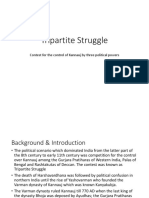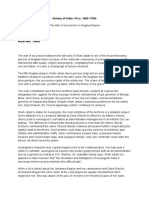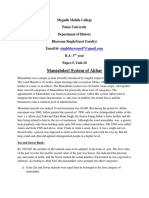All questons carry equal marks. Q1. When did Shivaji's Carnatc campaign (1677-78 AD) sar? Wha kind of arrangemen was made for he expansion of Shivaji's kingdom?Answer;
Chhatrapati Shivaji Maharaj undertook a campaign of the South in October 1677, after three years of coronation. He went to Golconda, where he called on the Qutubshah and enteredinto a treaty of friendship with him. Later, Shivaji Maharaj won Bengaluru, Hoskote in Karnataka,Jinji, Vellore, etc.
Shivaji was the son of Shahji Bhonsle by his first wife Jija Bai. He was born in the fort of Shivner, near the city of Junnar, north of Poona, on 20 April 1627. Shahji Bhonsle had been one among those nobles who were king-makers in the kingdom of Ahmadnagar. After its extinction, he transferred his services to Bijapur.There too he wielded good influence and power at the court. He married another woman, Tuka Bai Mohite. Therefore, Jija Bai, his first wife, decided to live separately from her husband. She kept Shivaji, his son with her. Shahji assigned the Jagir of Poona to his wife and left one of his loyal officers, Dadaji Kond Deva to look after them.
Q2. Menton he formaton of independen saes ha came ino exisence as a resul of he process of disinegraton of he Mughal Empire in he middle of he 18h cenury.
Answer;
The great Mughal Empire declined and disintegrated during the first half of the 18
th
The Mughal Emperors lost their power and glory and their empire shrank to a few square miles around Delhi.
In the end, in 1803, Delhi itself was occupied by the British army.
The unity and stability of the Empire had been shaken during the long and strong reign of Aurangzeb.On Aurangzeb's death, his three sons fought among themselves for the throne.
The 65-years-old Bahadur Shah emerged victorious. He was learned and dignified.
He adopted a more tolerant attitude towards the Hindu chiefs and rajas.
Unfortunately, his death in 1712 plunged the Empire once again into civil war. A new element enteredMughal politics in this and the succeeding wars of succession,
While previously the contest for power had been between royal princes, and the nobles had merelyaided the aspirants to the throne, now ambitious nobles became direct contenders for power and used princes as mere pawns to capture the seats of authority.
In the civil war following Bahadur Shah's death, one of his less able sons, Jahandar Shah, won because he was supported by Zulfiqar Khan, the most powerful noble of the time.
Jahandar Shah's inglorious reign came to an early end in January, 1713 when he was defeated at Agra by Farrukh Siyar his nephew.
Farrukh Siyar owed his victory to the Saiyid brothers, Abdullah Khan and Husain Ali Khan Barahow,who were therefore given the offices ofwazir and mir bakshi respectively
The two brothers soon acquired dominant control over the affairs of the state.
Farrukh Siyar
lacked the capacity to rule. He was cowardly, cruel, undependable and faithless.
In 1719, the Saiyid brothers deposed and killed him. In his place they raised to the throne in quick succession two young princes who died of consumption.
The Saiyid brothers now made the 18-years-old Muhammad Shah the Emperor of India. The threesuccessors of Farrukh Siyar were mere puppets in the hands of the Saiyids.
The Saiyid brothers, known in Indian history as the ‘
king makers’.
In 1738,
Nadir Shah,
the ruler of Persia (Iran), descended upon the plains of northern India. He wasattracted to India by the fabulous wealth for which it was always famous.
He entered Indian territory towards the end of 1738, without meeting with any opposition. The twoarmies met at Kamal on 13 February, 1739 and the invader inflicted a crushing defeat on the Mughalarmy.
The Emperor Muhammad Shah was taken prisoner and Nadir Shah marched on the Delhi. A terriblemassacre of the citizen of the imperial capital was ordered by Nadir Shah as a reprisal against thekilling of some of his soldiers.
The greedy invader took possession of the royal treasury and other royal property, levied tribute on theleading nobles, and plundered the rich of Delhi.
He also carried away the famous
Koh-i-Noor diamond
and the jewel-studded Peacock
Throne
of Shahjahan.
Ahmad Shah Abdali
, one of Nadir Shah's ablest generals, who had succeeded in establishing hisauthority over Afghanistan after his master's death.
Abdali repeatedly invaded and plundered northern India right down to Delhi and Mathura between1748 and 1767.
In 1761,
he defeated the Marathas in the
Third Battle of Panipat
and thus gave a big blow to their ambition of controlling the Mughal Emperor and thereby dominating the country.
As a result of the invasions of Nadir Shah and Abdali and the suicidal internal feuds of the Mughalnobility, the Mughal Empire had by 1761 ceased to exist in practice as an all-India Empire.
Shah Alam II, who ascended the throne in 1759, spent the initial years as an Emperor wandering from place to place far away from his capital.
In 1764, he joined Mir Qasim of Bengal and Shuja-ud-Daula ofAwadh in declaring war upon theEnglish East India Company.
Defeated by the British at the
Battle of Buxar,
he lived for several years at Allahabad as a pensioner of the East India Company. He left the British shelter in 1772 and returned to Delhi under the protective arm of the Marathas.
The British occupied Delhi in 1803 and from that year till 1857, when the Mughal dynasty was finallyextinguished.
Indian States and Society
During the 18th century, on the debris of the Mughal Empire and its political system, arose a largenumber of independent and semi-independent powers such as the Bengal, Awadh, Hyderabad, Mysoreand Maratha kingdoms.
Some of these states, such as Bengal, Awadh and Hyderabad, may be characterised as "successionstates'.
Q3. How was he Indian sociey divided and wha was he conditon of he peasans and he lower classes? Vaishya class under wha circumsances did he rise ake place? Answer;
At the bottom of the heap were the Shudras, who came from Brahma's feet and did all the menial jobs. The main castes were further divided into about 3,000 castes and 25,000 sub-castes, each based on their specific occupation. Outside of this Hindu caste system were the achhoots - the Dalits or the untouchables.
Vaishya, also spelled Vaisya, third highest in ritual status of the four
varna
s (or colours) sprang from Prajapati, a creator god—in order of status, the Brahman (white) from his head, the Kshatriya
(red) from his arms, the Vaishya (yellow) from his thighs, and the Shudra (black) from his feet. The yellow colour associated with the Vaishyas, according to one theory, links them with the south point of the compass. The Vaishyas were commoners, not servile groups. Their role lay in productive labour, in agricultural and pastoral tasks, and in trading. Their way of life demanded study, sacrifice, and the giving of alms. Early scriptures show that a Vaishya could and did rise even to the rank of Brahman, as in the case of the two sons of Nabhagarishta, mentioned in the sacred work
The Vaishyas share with the two higher classes, the priestly Brahmans and the authoritative Kshatriyas, the distinction of being
dvija
, or “twice-born,” achieving their spiritual rebirth when they assume the sacred wool thread at the
ceremony. The Vaishyas are credited in history with favouring the rise of the reformist religious beliefs of Buddhism and Jainism.
Q4. Discuss he various heories relaed o he rise of Rajpu’s in he early medieval period.Answer;
The Origin of Rajputs is a subject of debate. There are many theories that support their origins such asthe Agni Kula theory, Tribal Origin theory, Foreign Origin theory, Kshatriya Origin theory, and mixedorigin theory.
Rajputs belonged to the early medieval period.
The Rajput Period (647A.D- 1200 A.D.)
From the death of Harsha to the 12th century, the destiny of India was mostly in the hands of variousRajput dynasties.
There were nearly 36 Rajput’ clans. The major clans were:
1.The Palas of Bengal2.The Chauhans of Delhi and Ajmer 3.The Rathors of Kanauj4.The Guhilas or Sisodiyas of Mewar 5.The Chandellas of Bundelkhand6.The Paramaras of Malwa7.The Senas of Bengal8.The Solankis of Gujarat
Pala Dynasty
Gopala (765-769 A.D.)
Founder of Pala Dynasty and he also restored order.
Ruled over Northern and Eastern India.
He expanded the Pala dynasty and extended his power over Magadha
.
Dharmapala (769-815 A.D.)
He is the son of Gopala and succeeded his father.
He brought Bengal, Bihar, and Kanauj under his control.
He defeated the Pratiharas and became the master of Northern India.
He was a steadfast Buddhist and founded the famous Vikramasila University and several monasteries.
He also restored the Nalanda University.
Q5. How would you characerize politcal and economic srucure of early medieval India?Answer;
The Indian subcontnen saw a long era of Pos-classical hisory known as “medieval India” or he Age of Regional Conguratons beween “old tme” and “modern period. Alhough some hisorians believe i began and ended laer, i is generally acceped ha he Early medieval period began in 1526 wih he esablishmen of he Mughal Empire and lased untl he fall of he Gupa Empire in he 6h cenury AD. There are wo sub-periods wihin he mediaeval period: he early and lae periods.Each sae on he Indian subcontnen had is own distnc culure, language, writng sysem, and religion during he Early Middle Ages.Boh erms “classical” and “ancien India” can be used for periods wih signicanly varied daes, especially inspecialised disciplines such as ar or religious hisory, and he Gupa Empire’s gradual fall from 480 o 550 heend of he “classical” period.
Main Characteriscs of Medieval India Age:
1.Medieval India refers o he period beween he ancien and modern eras in India.2.Human developmen was acceleraed o a signican exen hroughou he Medieval Period.3.The Pope’s and he Church’s auhoriy grew.4.The Religious Teachings were blindly adhered o.5.In comparison o blind faih, hinking was of lile consequence.6.Independen hough was sted.7.The Crusades were religious warfare beween Christans and Muslims ha alered he rajecory of European hisory.8.Changes in lieraure and science arose from conac wih Arabs and he inuence of Islam.9.In Europe, here was no srong cenralised governmenal auhoriy.10. Anarchy swep across Europe as a resul of he invasion of barbarous ribes.11. Laer, in Europe, he Renaissance began.







































































